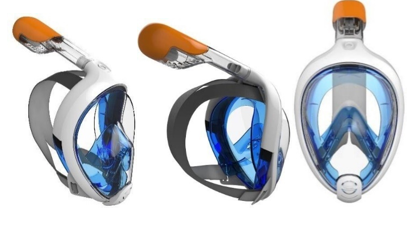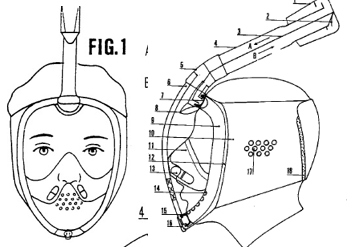EU General Court offers lifeline to Decathlon in Easybreath mask design ruling

The recent dispute over the Decathlon 'Easybreath' mask offers helpful clarity about the protection provided by EU design rights, says Florence Chapin. She dives into the ruling and the key takeaways for innovators.
On 4 June 2025, the EU General Court issued its decision in Delta-Sport Handelskontor v EUIPO (Case T-1060/23). Delta-Sport had sought a declaration of invalidity of Decathlon’s design for a full-face snorkelling mask based on prior and similar designs, as well as an earlier patent. For its ruling, the court considered whether all features of the design were imposed by technical function (a key concept under EU design law), as well as whether there were significant visual differences between the Easybreath mask and the prior designs.
Background to the Easybreath mask dispute
In 2013, Decathlon led an application at the European Union IP Office (EUIPO) to protect the design of a full-face snorkelling mask, known as the ‘Easybreath’ mask. This mask is characterised by its rounded shape, wide field of vision and integrated snorkel at the top.
In 2021, a competing company, Delta-Sport Handelskontor GmbH, led an action for a declaration of invalidity of the design, arguing that it lacked novelty and individual character. In support of its claims, Delta-Sport relied on prior similar designs, as well as an earlier patent.
After the EUIPO Cancellation Division dismissed the invalidity application in July 2022, Delta-Sport lodged – and lost – an appeal. In particular, the Board of Appeal held that Delta-Sport had failed to demonstrate that the technical function of the product had exclusively dictated the features of the contested design.
Moreover, it found that the design possessed individual character, notably due to several significant differences from a prior disclosure found in a French patent application dating from 1995, as illustrated below:
| Decathlon Easybreath mask | 1995 French patent application (FR2720050) |
 |
 |
Delta-Sport brought an action before the EU General Court to challenge this ruling, arguing that the essential features of the contested design were solely imposed by the technical function of the product. In particular, it asserted that the oval, rounded shape of the frame corresponds to human facial anatomy, and the head strap serves exclusively to ensure that the mask is securely and comfortably fixed to the head.
Legal framework and analysis
To assess the validity of a registered Community (EU) design in light of the exception relating to technical function, a three-step test must be applied:
- 1. Identify the technical function of the product;
- 2. Analyse the features of the appearance of the product; and
- 3. Evaluate, in light of all relevant objective circumstances, whether those features are exclusively dictated by the need to fulfil that function.
In other words, the aim is to determine whether the technical function was the sole factor that guided the designer’s choices in developing those visual elements.
Depending on the complexity of the product, the identification of the relevant features of appearance may be based either on a simple visual analysis or a more in-depth examination. The latter may draw on supporting materials such as studies, technical expert opinions or prior IP rights granted for the same product. According to case law, as long as at least one of the product’s features of appearance is not exclusively dictated by technical function, invalidity under Article 8(1) of Regulation 6/2002 cannot be declared. The existence of even a single non-functional feature is sufficient to preserve the validity of the design.
Conversely, where all the features of a product’s appearance are exclusively dictated by functional requirements, the design must be held invalid. However, this conclusion may be avoided where the arrangement or configuration of the features is guided by considerations beyond pure functionality – such as when the overall arrangement produces a distinct visual impression exceeding mere utility (see Case T-574/19, Paragraph 25).
In the case of the Easybreath mask, the contested design was found to possess the following features of appearance:
- a white/grey oval peripheral frame surrounding the face;
- a transparent lens, flat at the top, rising over the nose area and narrowing progressively towards the chin, inserted into the frame;
- a skirt composed of a partition above the mouth and nose in an inverted ‘V’ shape, with a valve on each side and a vented cover in the chin area – both the skirt and the inner rim of the lens being blue in colour;
- a semi-circular flat snorkel that thickens notably from the midpoint to the top end, fitted with a cap – the snorkel being orange at the tip and transparent along the tube, positioned at the top centre of the frame and inclined at a 45-degree angle; and
- a black X-shaped head strap joined at the centre and attached to the mask via two fixing eyelets located slightly above the chin.
EU General Court decision
The court upheld the validity of the Easybreath mask design, highlighting the following:
- Not all features of the design were imposed by technical function: “Both the shape of the frame and the configuration of the head strap result from considerations other than purely technical ones and, as rightly noted by the Board of Appeal, are also influenced by aesthetic aspects.”
- In carrying out a detailed assessment of the overall impression produced by the contested design from the perspective of the informed user, the court identified significant visual differences between the Easybreath mask and the prior designs invoked, particularly in terms of proportions, shapes, fixation methods and aesthetic details.
Key takeaways from the Decathlon EU design ruling
The judgment represents a notable victory for Decathlon. It illustrates that technically complex products may still benefit from Community/EU design protection, provided that their appearance includes a perceptible creative element that goes beyond mere functionality.
To find out more about protecting EU designs, download our guide to EU design reform, speak to your Novagraaf attorney or contact us below.
Florence Chapin is a French and European Trademark Attorney based at Novagraaf in Bordeaux.
This article first appeared in WTR Daily, part of World Trademark Review, in June 2025. For further information, please go to www.worldtrademarkreview.com.
